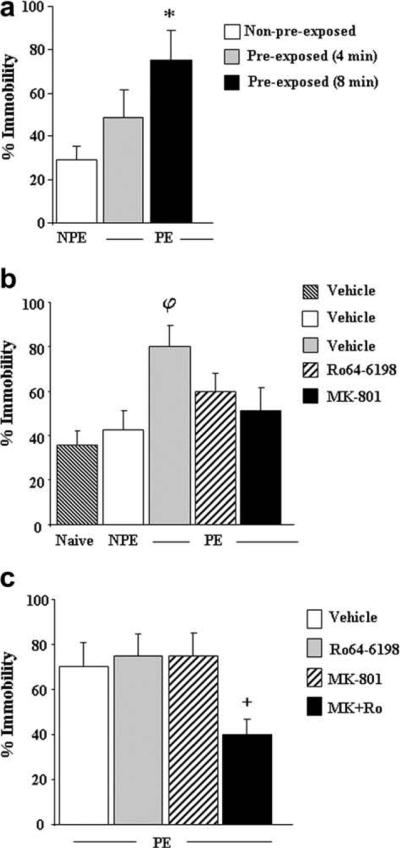Fig. 3.
Effects of Ro64-6198 and MK-801 on contextual memory formation. (a) Effects of preexposure to training context on post-shock freezing behavior during the immediate shock deficit conditioning session. Preexposed groups (PE): mice were preexposed to the training context for 4 or 8 min and submitted the following day to the immediate shock deficit (ISD) conditioning session (n = 8 per duration). NPE: Non-preexposed control group (n = 17). (b) Effects of Ro64-6198 (1 mg/kg) and MK-801 (0.1 mg/kg) on the facilitation effects of context preexposure. Preexposed groups (PE): mice received an injection of vehicle (n = 9), Ro64-6198 (n = 8) or MK-801 (n = 7) before preexposure to training context (8 min duration) and submitted the following day to ISD conditioning session. NPE: non-preexposed mice received vehicle injection in their home cage in the first day and submitted the following day to the ISD conditioning session (n = 8). Naïve: non-preexposed mice that did not experience the foot-shock during the ISD conditioning session. (c) Effects of Ro64-6198 (0.5 mg/kg) and MK-801 (0.05 mg/kg) administered alone (n = 6–8 per treatment) or conjointly (n = 7) on the facilitation effects of context preexposure. Preexposed groups (PE): mice received drug treatments before preexposure to the training chamber and submitted to the ISD conditioning session the following day. Data are expressed as mean ± SEM percentage of immobility. *p < 0.05, significantly different from NPE control group (Tukey–Kramer post-hoc test). φp < 0.05, significantly different from naïve and NPE control groups (Tukey–Kramer post-hoc test). +p < 0.05, significantly different from vehicle-treated counterparts (Tukey–Kramer post-hoc test).

